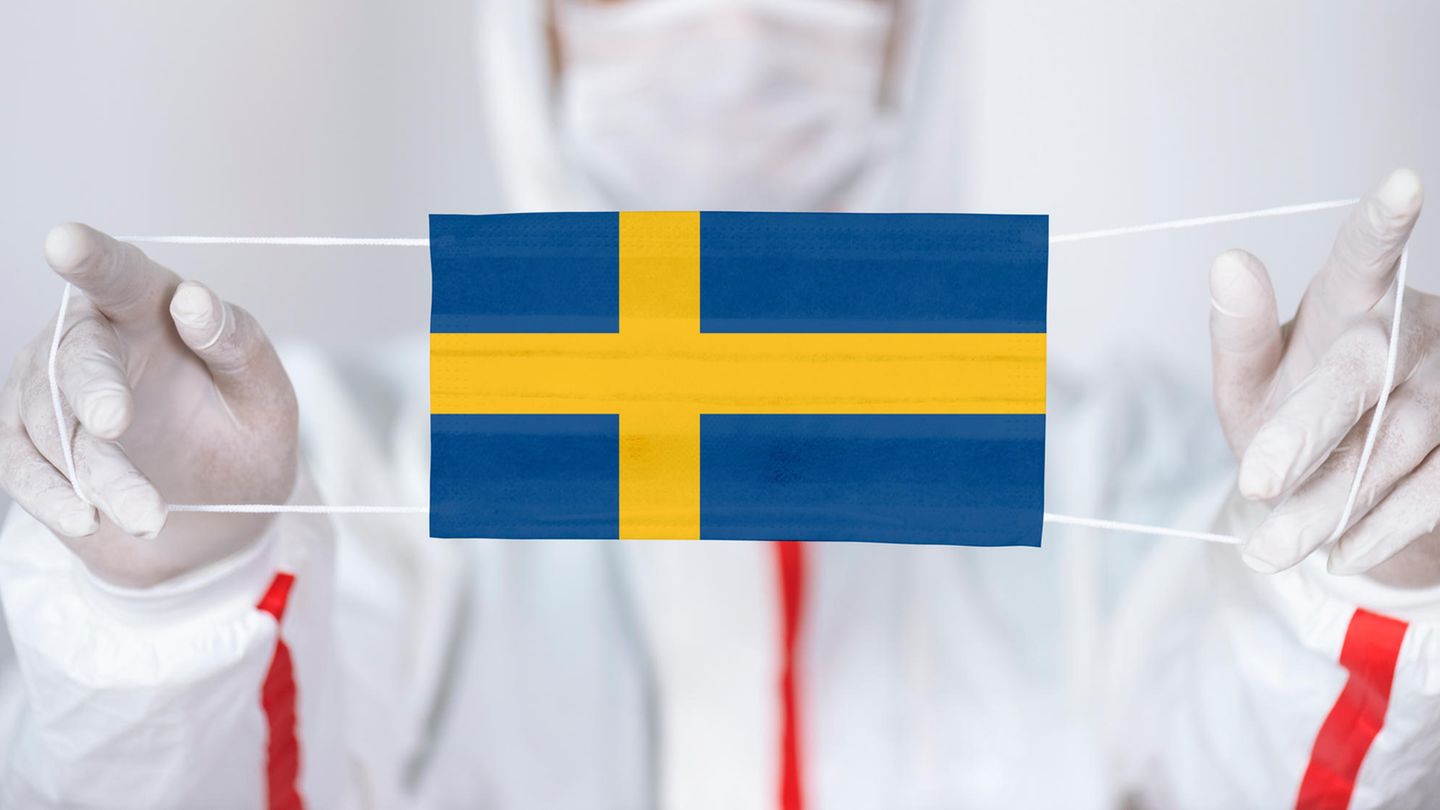Sweden caused a stir internationally with its more relaxed course in the corona pandemic. Now the country wants to lift all restrictions. How has the country fared with its special path?
The “Swedish special path” – a term that attracted a lot of attention worldwide, especially in the first year of the corona pandemic. While many other countries went into lockdown, closing schools, shops, restaurants and much more, Sweden took a different path. Not all students were sent to homeschooling. Many shops remained open and it was also possible to visit restaurants. Mask requirement? never was. For some, that was the right strategy. Here and there you could see a Swedish flag at demonstrations against the German Corona policy.
The others reacted by shaking their heads at the Swedish way. The media reported extensively on the “special path” of the Swedes, and it was not uncommon for it to be criticized – also in star.
Sweden’s comparatively relaxed corona measures will very soon be a thing of the past. Almost all restrictions are to be lifted from February 9th. “The pandemic is not over, but we are at the beginning of a completely new phase,” Prime Minister Magdalena Andersson said on Thursday. Various studies have shown that the omicron variant of the virus “leads to less serious diseases”. Despite the high number of new infections, the number of intensive care patients remained stable. The vaccination numbers are also high. Taken together, this means a new situation, said the head of government.
Curfew and proof of vaccination are abolished
In Sweden, two corona vaccine doses have been received for more than twelve years. Around half of the adult population has been triple vaccinated against the virus. The situation is similarly good: Here the booster rate for all over 18-year-olds is 63.1 percent. The rate of double vaccination among the over 12-year-olds is similarly high in Germany.
After the easing comes into force on Wednesday next week, the curfew for bars and restaurants, which previously applied from 11 p.m., will be lifted. The restriction on the number of visitors at events will be lifted, as will the obligation to show proof of vaccination at indoor events. The government also wants to lift the recommendation to wear a mask on public transport at peak times.
According to the government, there should be gradual easing when employees return to the office from their home office and when transitioning from digital teaching to face-to-face teaching at universities. For those who have not been vaccinated, the recommendation to avoid large crowds of people should also apply after the easing has come into force.
Many elderly in Sweden have died during the pandemic
“Even if the pandemic has entered a different phase, it is definitely not over yet,” emphasized Swedish chief epidemiologist Anders Tegnell. He also thinks it’s important to be prepared for a change in the situation – and to keep getting vaccinated. “If we start losing those parts, there’s a big risk that we’ll get into trouble again.” Still: “I believe that if we don’t correct the restrictions according to the development that we see in the spread of infections, we will lose credibility.” It’s not reasonable that the disease should be seen as dangerous to society, he says.
So Sweden is leaving the pandemic behind. But how has the country fared over the past two years?
What was criticized, especially at the beginning of the pandemic, was the high death rate in Sweden. Nationwide, more people have died in the country of ten million people since the beginning of the pandemic than in connection with the corona virus. In the second and third corona wave at the end of 2020 and beginning of 2021, the country had very high infection and death rates compared to other European countries.
A November 2020 health inspectorate investigative report on the first wave of the pandemic found that the goal of protecting vulnerable groups (old and sick) had been missed. According to this, three quarters of the corona dead were in need of care. A very large proportion of the dead were older than 70 years.
Recommendations and voluntariness would have “worked moderately well”
The Swedes’ lockdown-free path was not particularly successful economically either. A recession could not be prevented. The reasons for this were, on the one hand, a significant drop in consumption and, on the other hand, companies that invested less or sent their employees to work from home or even cut jobs entirely. Gross domestic product fell by 2.8 percent in 2020 compared to the previous year. A stronger slump could only be prevented with extensive economic aid from the state. At the end of 2020, the unemployment rate was a third higher than in the previous year.
Science has also dealt with the special path of the Swedes. Among others, Arash Heydarian Pashakhanlou from the Swedish Defense University. In June last year he wrote in his article on the much-criticized approach of the health authorities to relying on voluntary measures for many corona measures: “Overall, the available data indicate that a considerable part of the Swedish population believes in the voluntary recommendations of the health authorities heart. (…) As such, the available evidence suggests that voluntarism has worked moderately well.”
Many elderly people in Sweden appear to have lost their lives prematurely during the pandemic, Pashakhanlou said. “It is impossible to put a figure on the number of lives that could have been saved through earlier testing and implementation of the recommendations issued by the health authority.” However, he emphasizes that the responsibility for care lies with the respective municipalities – and not with the state health authority.
Report: poor protection for the elderly
An October last year assessment of Sweden’s corona policy concludes: “In the periods March – June 2020 and November 2020 – January 2021, mortality in Sweden was significantly higher than in the same period of previous years.”
The more than 800-page report goes on to say that the risk of dying from Covid-19 was structured similarly for people from different population groups to the risk of dying from other causes. However, the risk was higher for foreign-born and remarkably high for older people in nursing homes. For older people in old people’s and nursing homes, the risk of dying from Covid-19 remains high during the second wave of the pandemic. “We find that very disappointing. When we wrote our first report, we hoped that the experiences in geriatric care from the first wave would lead to better protection for older people in special facilities. That was obviously not the case,” concludes the commission of inquiry . The corona virus got into the care facilities in particular via employees.
In addition, there was a lower test propensity in the population groups that had the greatest risk of contracting severe Covid-19. “In addition, we find it remarkable that even in the second and third waves of the pandemic, such a significant proportion of Covid-19 patients were hospitalized without a prior positive test.”
Swedish pandemic preparedness “below average”
At the same time, the report underlines that isolation and reduced contact have led to a deterioration in the well-being of many people. Especially for people with addiction problems, this has led to a worsening of the situation or to relapses. Loneliness has worsened.
Their summary of the report states: “Sweden’s handling of the pandemic was marked by delays. The initial protective measures against the infection were not sufficient to stop or even severely limit the spread of the infection in the country.” The Commission criticizes that the Swedish pandemic preparedness was below average. Infection control legislation is insufficient “to deal with a serious outbreak of an epidemic or pandemic.”
The Royal Academy of Sciences in Sweden also looked at it and asked the question in a report last November. Here, too, the lack of preparation at the beginning of the pandemic is criticized. “Particularly in geriatric care, the lack of preparation contributed to the high mortality rate in Sweden in the first phase of the pandemic. Among other things, there was a lack of protective material, but also a lack of sufficient insight into the airborne infection and thus the need for a face mask / mask Face mask for everyone who comes into contact with the elderly.” It has often been impossible for caregivers to take the expected responsibility for the safety of users.
Strategy probably led to higher numbers in Sweden
According to the report, the low testing capacity at the beginning of the pandemic may have led to the actual spread of the infection in the country being overestimated. The preparation for a pandemic situation was also insufficient in the hospitals. The Swedish vaccination strategy, on the other hand, is satisfactory, according to the scientists.
They conclude: “The Swedish pandemic strategy has likely contributed to Sweden’s significantly higher rates of infection, disease and death compared to Denmark, Norway and Finland.” The introduction of infections from abroad and the limitation of local outbreaks were given little consideration. “Lessons learned from the first wave, with high numbers infected, were not sufficient to deal with the expected second wave of contagion. Very little of the experience of other countries has been used to combat the more contagious alpha and delta variants than ours land,” they conclude.
Other sources: “The new cosmos world almanac 2022”, , ,
Source: Stern




